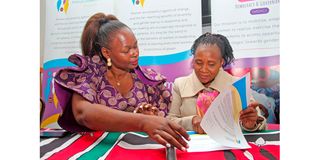Women’s Equality Day: Here’s status outlook in Kenya

Women Political Leaders Kenya chairperson Pamela Ateka (left) with Catherine Rita during a media briefing in Nairobi on August 23, 2022. They asked that women who vied in the General Election and fought on equal terms with men be given first priority in appointments and nominations.
What you need to know:
- In the past three years, nearly a triple number of girls acquired STEM education.
- A huge improvement was also recorded in engineering, manufacturing and construction training.
- In 2020 and 2021, 9.16 million women were in the labour force versus the 9.51 million of men.
In the past three years, nearly a triple number of girls acquired science, technology, engineering, and mathematics (STEM) education, an analysis of the global gender gap reports reveal.
Analysis of the consecutive reports by World Economic Forum since 2020, shows 30.73 per cent of girls had STEM education in 2022 compared to 11.19 per cent in 2020.
A huge improvement was also recorded in engineering, manufacturing and construction training. The number significantly jumped to 19.46 per cent in 2022 from 1.82 per cent, two years ago.
Men, however, overtook the women in 2022 in access to health and welfare education.
For the two years (2020 and 2021), 6.48 per cent of women against 5.56 per cent of men received the respective skills.
But in 2022, men constituted 50.94 per cent of the graduates compared to 49.06 per cent of women.
In natural sciences, mathematics and statistics, the men maintained the lead. For 2020 and 2021 the numbers remained at 5.88 per cent for women and 7.93 per cent for men.
The women’s proportion in the training rose to 37.99 per in 2022 while men’s remained high at 62.01 per cent.
In terms of labour force participation, the gap is narrower. In 2020 and 2021, 9.16 million women were in the labour force versus the 9.51 million of men.
In 2022, of the total labour force, women were 12.29 million and men, 12.69 million.
But more women (3.13 per cent) aged 15-64 were in 2020 and 2021 unemployed (3.13 per cent) compared to 2.73 per cent of men
The trend remained the same in 2022 where 5.85 per cent of unemployed Kenyans were women against 5.21 per cent of men.
On corporate leadership, in 2020 and 2021, only 18.10 per cent of women were top managers in Kenyan firms. Missing in the 2022 report is the current status of gender representation in top management.
In Parliament, the representation of women dropped from 21.8 per cent in 2020 to 21.6 per cent in 2021, which would be attributed to the death of Baringo South Member of Parliament Grace Kipchoim. A man was elected in the by-election to replace her.
The report further shows a drop in representation to 21.40 per cent in 2021 though Agnes Kavindu was elected senator of Machakos County, raising the number of elected senators to four.
The analysis also shows more appointment of women to ministerial positions. The representation jumped from 25 per cent in 2020 to 30.4 per cent in 2022.





